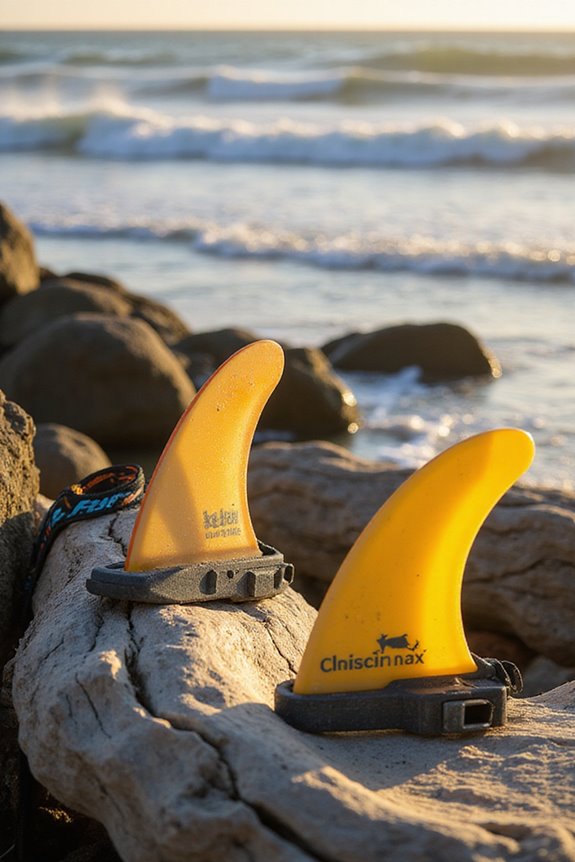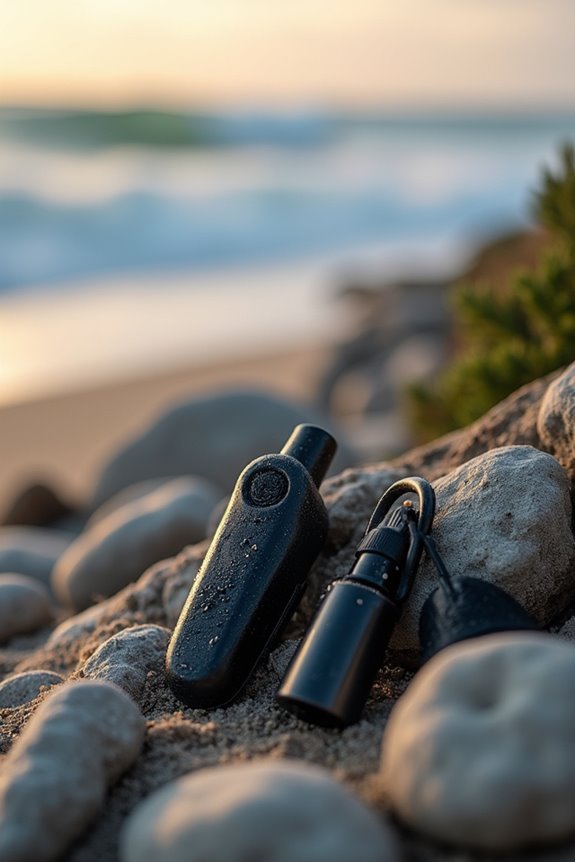To overcome our fear of wipeouts, we should focus on mental conditioning, gradual exposure, and community support. We can practice visualization techniques to prepare us for wipeouts, use mindfulness to stay present during sessions, and employ breathing techniques to regulate stress. Incremental exposure to larger waves can build our confidence. Engaging with supportive surfing communities and participating in surf therapy can also enhance resilience. By exploring these strategies, we can better manage our fears.
Key Takeaways
- Practice cognitive reframing by viewing wipeouts as valuable learning experiences to reduce anxiety and increase resilience.
- Regularly implement visualization techniques to mentally prepare for wipeouts and replace fear with calmness.
- Use breathing techniques, like slow deep breathing, to calm your nerves and enhance focus during challenging surf conditions.
- Gradually expose yourself to bigger waves and practice wipeout recovery to build confidence and improve your skills over time.
- Engage with a supportive surfing community to share experiences, gain encouragement, and foster skill development in a safe environment.
Understanding the Fear of Wipeouts
When we think about wipeouts in surfing, it’s important to recognize that fear often stems from an instinctive response to danger. Waves can exert tremendous force, triggering our brain’s danger response rapidly. This reaction, while protective, can lead to panic, which complicates our ability to think clearly.
To combat this, we can develop emotional resilience through techniques like cognitive reframing. By changing our perspective on wipeouts—from viewing them solely as threats to seeing them as learning experiences—we can reduce anxiety. Focusing on positive memories of past successes helps reinforce our confidence. Additionally, incorporating core strengthening workouts into our training can enhance our stability and control in the water. By practicing these strategies, we can learn to manage fear, enabling us to tackle more challenging waves without hesitation.
The Importance of Mental Conditioning

Although many athletes focus primarily on physical training, mental conditioning is equally essential for achieving success in sports like surfing. Developing mental toughness allows us to manage stress and regulate our emotions effectively, which enhances our performance consistency.
By incorporating systematic mental training into our routines, we can strengthen our resilience and perseverance under pressure. Techniques like goal-setting and positive self-talk elevate our confidence and self-efficacy, allowing us to overcome challenges.
Moreover, training to recognize and reframe anxiety helps us maintain functional arousal during competitions. With consistent mental rehearsal and mindfulness exercises, we can prepare ourselves to handle wipeouts calmly, ensuring we face high-pressure situations with control and confidence. Additionally, engaging in yoga practice can enhance our balance and flexibility, further contributing to our overall performance in surfing.
Visualization Techniques for Preparation

To maximize our performance and effectively manage the fear of wipeouts, we can utilize various visualization techniques tailored to our specific needs. One effective method is scenario visualization, where we mentally rehearse specific moves and entire sequences. This prepares us for the exact conditions we may face, including worst-case scenarios.
We should also focus on emotional regulation through visualization. By simulating high-pressure situations, we can replace negative emotions like fear with feelings of calm and confidence. Practicing relaxation techniques through vivid imagery helps reduce anxiety, allowing us to face challenges with a composed mindset. Regularly implementing these techniques builds mental resilience, enhancing our ability to manage wipeout fears effectively during performance. Additionally, incorporating mindfulness practices can further strengthen our ability to respond to fear without immediate reaction.
Mindfulness Practices to Stay Present

In order to effectively manage our fear of wipeouts, practicing mindfulness can help us stay grounded in the present moment. Mindful awareness encourages us to focus on our bodily sensations, such as the feeling of the water or the board beneath our feet. This technique helps redirect our attention from fear triggers.
We can also acknowledge our fear thoughts without judgment, allowing them to pass without engaging further. Using sensory awareness, like noticing the sounds of the ocean or the smell of saltwater, can anchor us in the present moment. By cultivating mindful acceptance, we can reduce the impact of fear and increase our emotional resilience, enhancing our overall experience in the water. Additionally, incorporating urge surfing techniques can empower us to navigate our fears with greater confidence.
Breathing Techniques for Stress Regulation

- Slow Deep Breathing: This method decreases anxiety and lowers physiological arousal by calming our autonomic nervous system.
- Cyclic Sighing: Involves two inhales followed by a long exhale, promoting greater mood enhancement and reducing anxiety levels.
- Extended Exhalation: Focusing on lengthening the exhale phase is particularly effective in improving mood and reducing stress. Incorporating essential surfing gear into your routine can help build confidence and reduce fear while riding the waves.
Practicing these techniques for at least five minutes daily helps to sustain lower anxiety levels and fosters emotional resilience. By integrating these breathing practices, we can create a more relaxed state, enhancing our overall well-being.
Learning From Wipeouts: a Growth Perspective
Learning from wipeouts can greatly enhance our surfing journey and personal growth. Each wipeout serves as a valuable data point for wipeout analysis, allowing us to reflect on our failures. Instead of viewing these moments as setbacks, we can see them as opportunities for improvement.
By repeatedly attempting waves and making small adjustments, we increase our chances of success. Failure reflection helps us recognize specific errors, such as poor balance or positioning, guiding us toward skill refinement. This iterative process not only builds our surfing skills but also cultivates resilience, particularly when learning from the experienced instructors who can provide valuable feedback. Embracing each wipeout as a learning experience empowers us to approach future challenges with confidence and a growth mindset, essential for mastering the waves.
The Role of Surf Therapy in Building Resilience
The practice of surf therapy plays an essential role in building resilience among participants, particularly those facing mental health challenges. It creates a safe space for emotional and physical growth, allowing individuals to progress at their own pace.
Key benefits of surf therapy include:
- Social Integration: Participants connect with peers, fostering social trust and reducing feelings of isolation.
- Skill Development: Learning to surf encourages mastery of new skills, which boosts self-esteem and reduces anxiety.
- Emotional Resilience: Experiencing the ocean’s calming effects enhances relaxation and self-care practices.
Through these mechanisms, surf therapy not only improves mental health outcomes but also strengthens our ability to cope with life’s challenges, ultimately contributing to resilience building.
Spirituality and Its Impact on Fear Management
Spirituality plays an important role in managing fear, as it helps us develop effective coping mechanisms. By fostering spiritual resilience, we can decrease our emotional focus on fear while enhancing our concentration on daily tasks. Engaging in faith practices, like prayer or meditation, provides us with a framework for interpreting fear-provoking situations, making them more manageable.
Additionally, spiritual well-being can protect against anxiety and depressive symptoms, especially in challenging times. When we participate in spiritual or religious activities, we often find support that reduces our psychological burdens. This coping strategy not only promotes positive perspectives but also strengthens our mental health, allowing us to approach fear with greater confidence and resilience.
Practical Steps for Gradual Exposure
When we face our fear of wipeouts, it’s essential to take practical steps for gradual exposure to build confidence and resilience.
1. Learn Water Safety****
Start by swimming confidently to reduce basic aquatic fears. Understanding ocean dynamics, like currents and tides, enhances our situational awareness.
2. Begin with Small Waves****
Engage with manageable waves of 1-2 feet at monitored beaches. Activities like bodyboarding can help us interact with water dynamics safely.
3. Use Incremental Exposure****
Gradually increase wave size and intensity. Frequent surf sessions allow us to practice wipeout recovery techniques, reinforcing our ability to handle challenges.
4. Incorporate Relaxation Techniques
Employ breath control and mindfulness during sessions to manage stress responses, helping us maintain composure and confidence in the water.
Building a Supportive Surfing Community
Creating a supportive surfing community can greatly enhance our overall surfing experience and personal growth. By engaging with others in boardriders clubs or local surfing organizations, we foster mutual support that improves our skills and confidence.
Benefits of Community Engagement
- Increases feelings of belonging and connectedness.
- Reduces feelings of isolation and enhances mental health through peer support.
- Encourages participation in surf therapy programs that promote resilience and emotional well-being.
Building Trust and Inclusivity
Involving certified instructors and safety personnel creates a safe environment, allowing us to focus on learning. By breaking down access barriers, we guarantee everyone, regardless of background, can join. This inclusive approach strengthens our bonds, making our surfing journey more enjoyable and fulfilling.
Frequently Asked Questions
Can Fear of Wipeouts Affect My Overall Surfing Performance?
They say, “What doesn’t kill us makes us stronger.” Our wipeout psychology can impact performance anxiety, leading to hesitation and reduced confidence. Embracing challenges can help us improve and enhance our overall surfing experience.
How Can I Identify My Specific Fears Related to Wipeouts?
To identify our specific fears related to wipeouts, we need to recognize our fear triggers. By employing mental strategies like reflecting on past experiences and monitoring our reactions, we can gain valuable insights into our anxiety.
What Are Common Physical Symptoms of Fear During Wipeouts?
Isn’t it amusing how our bodies betray us during wipeouts? We experience physical reactions like racing hearts and trembling muscles, revealing mental barriers we often underestimate. Recognizing these symptoms helps us understand our fears better.
How Do Wipeouts Influence My Surfing Technique Development?
Wipeouts teach us valuable lessons in technique refinement through wipeout recovery. By analyzing our falls, we identify mistakes and improve our positioning, timing, and balance, ultimately enhancing our overall surfing performance and confidence in the water.
Are There Any Long-Term Effects of Frequently Experiencing Wipeouts?
Frequent wipes can lead to trauma, affecting our cognitive and emotional health. We should prioritize recovery strategies to mitigate these long-term effects, ensuring we maintain our well-being and enjoy our time in the water.







